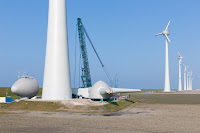Industrial chimneys and lighthouses have always
been bricked up, and so well that they are still
fully functional to this day and would be a while
if they weren't torn down. Today you would not
be able to pay for such a construction method
and you would no longer have the time to assemble
it.
Large or tall towers such as TV towers, radio masts,
offshore / onshore wind turbines and similar
structures are made of steel or reinforcing concrete.
High-quality UHPC materials can take on
compressive strengths of more than 240 MPa /
34.800 psi and thus corresponding bending tensile
strengths without reinforcement.
With appropriate reinforcement, these values can
be multiplied several times. Today, slim, high-
strength tower constructions are possible that
cannot be achieved with standard concrete. The
main tube construction of radio masts can also
be made entirely of UHPC today.
Towers for onshore and offshore wind turbines
are already made from UHPC prefabricated parts
or cast on site.
UHPC has many technical advantages over steel
or reinforced concrete structures. UHPC towers
are absolutely corrosion-resistant, quickly
installed and maintenance-free.










